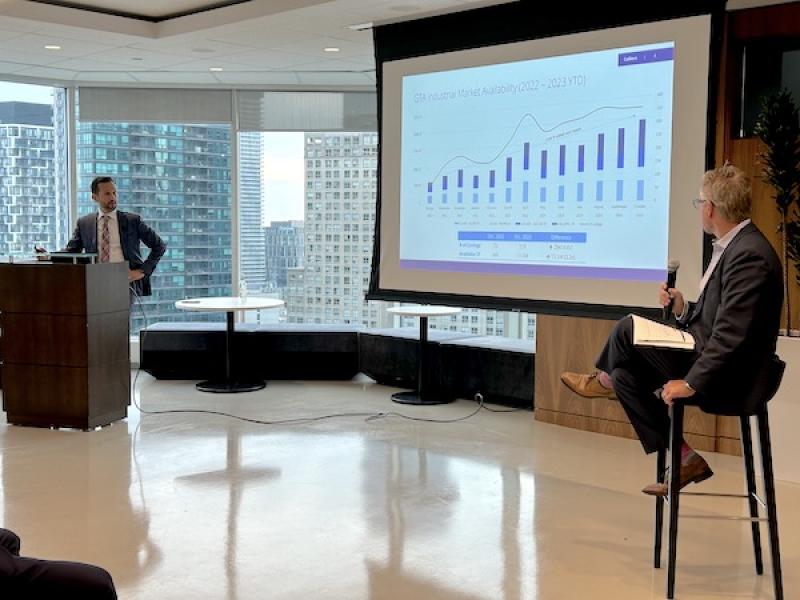
A room full of commercial real estate executives hosted by Colliers heard just how much the Greater Toronto Area (GTA) industrial market has slowed in 2023 after a couple of blockbuster years.
Rents that increased at an annualized rate of 37.6 per cent from the fourth quarter of 2021 to the third quarter of 2022 have risen at an annualized rate of 10.4 per cent since then, standing now at an average of $18.57 per square foot.
At the same time, the availability rate has grown from less than one per cent to 1.8 per cent today, attendees were told at the Nov. 23 event at Colliers’ downtown Toronto offices.
There were 75 industrial listings of more than 15,000 square feet, totalling approximately six million square feet, in October 2022. That compares to 359 totalling approximately 19.5 million square feet a year later as about a million square feet of new space has been added each month.
“The segment that’s seen the largest increase in listings are buildings over 200,000 square feet,” executive vice-president Victor Cotic said.
“That’s noteworthy because that is predominantly the type of building that will be delivered over the next few years. It’s not economically viable to build anything below 20,000 square feet unless it’s an industrial condo.”
Available sublet space is increasing
Sublet space in class-A industrial buildings over 50,000 square feet was relatively small as a percentage of total inventory through 2022, but more has come to the market this year – over two million square feet is now available.
Brampton is responsible for 45 per cent of that space, followed by Vaughan at 29, Caledon at 12, Toronto at nine and Mississauga at five per cent.
Amazon has 745,515 square feet available to sublet at its GTA facilities, comprising one-third of the total.
“The thesis is that Amazon had to grow very, very quickly to handle all of that COVID e-commerce demand, so they generally took on more space to make sure they had capacity,” vice-chairman Gord Cook surmised, “and now as things moderate, they’re really looking to mitigate the space that they don’t need.
“But their offering to the market is generally around sublet terms of about two years.
“That could actually help someone who doesn’t want to enter into a long-term lease, but it could also make it difficult for an organization that’s going to make an investment into the space.
“The last thing they’re going to want to do is a two-year term.”
Consumer goods companies account for 38 per cent of the available sublet space, while third-party logistics providers are responsible for 20 per cent and manufacturers nine per cent.
Future rent increases and escalators
Session attendees were polled on what average annual amount they think rents will increase by over the next two years.
Fifty-six per cent said between two and four per cent, 22 per cent said less than two per cent, 11 per cent said between 4.1 and eight per cent, six per cent said between 8.1 and 12 per cent, and another six per cent said between 12.1 and 15 per cent.
Most of the people in the audience were looking to achieve four to five per cent annual rent escalators in leases.
However, Cook said tenants are reluctant to enter a 10- or 15-year lease with four per cent annual escalators – leading to rates of nearly $30 per square foot at the end of the term – in case the growth of the economy and their business doesn’t keep pace.
“I think a lot of sophisticated tenants are willing to negotiate terms that might have fixed escalators for a certain period of the lease term, but if they’re entering into a 15- or 20-year contract they might want to look at introducing CPI (consumer price index) as the growth escalator later on in the lease.”
New supply and absorption
Approximately 3.1 million square feet of new industrial space was delivered annually in the GTA from 2009 to 2015.
That increased to about 5.9 million from 2016 to 2020 and 11.4 million in 2021 and 2022. It’s on pace for almost 11.1 million this year.
While annual net absorption averaged almost 12.6 million square feet over the past two years, it’s forecast to be approximately 3.4 million square feet in 2023.
Colliers’ 2024 speculative development pipeline forecasts:
- 5.93 million square feet from 24 projects in the GTA East;
- 2.17 million square feet from 14 projects in Vaughan;
- 1.98 million square feet from 12 projects in the GTA North;
- 1.96 million square feet from 11 projects in Mississauga;
- 1.94 million square feet from 10 projects in Burlington/Oakville;
- 1.34 million square feet from three projects in Brampton;
- 1.05 million square feet from five projects in the GTA Central;
- and 976,000 square feet from two projects in Milton/Halton Hills.
“We’ve got a lot of space coming on and we’re going to be sitting with inventory by the end of this year based on the absorption that we’ve seen,” said Cook. “I think the tap has been turned off for new development.”
If development drops off, Cotic said, it would keep putting pressure on existing inventory and keep availability low, which would lead to more rental growth.
“The good news is our market remains so tight that even if you project negative-five million square feet of net absorption next year, availability should remain well under five per cent,” Cotic said.
“But it’s moved up a lot more quickly than we would have predicted earlier this year.”
The investment market
Excluding end-user transactions, there were just over $4 billion in deals done last year. Institutional investors and fund managers accounted for about $2.6 billion.
Transaction volume has been about $2.7 billion this year, but institutions and fund managers have only been responsible for about $600 million.
Private buyers account for about 47 per cent of 2023 deal volume, much of it via smaller transactions.
“The market still remains incredibly liquid, but the profile has changed and obviously cap rates have moved up,” Cotic said.
The average per-square-foot transaction price has increased almost $50 this year over 2022 to $301.









